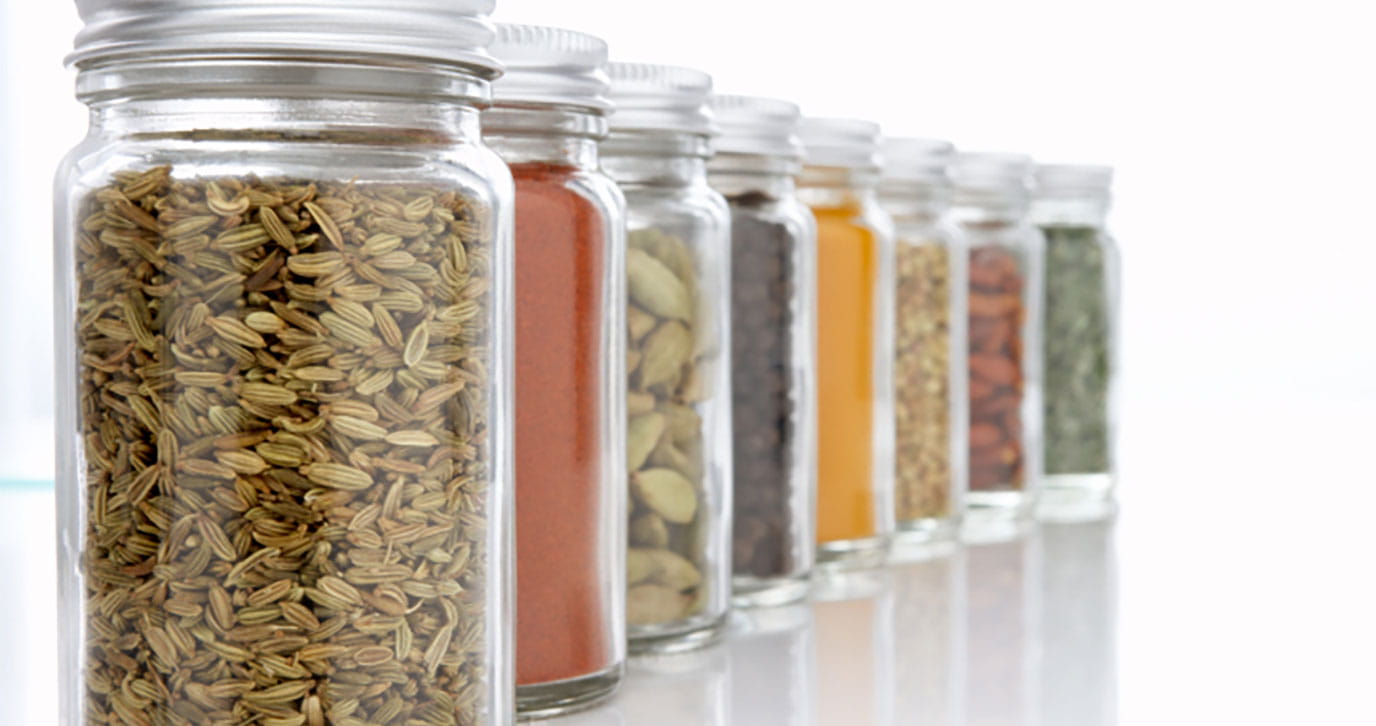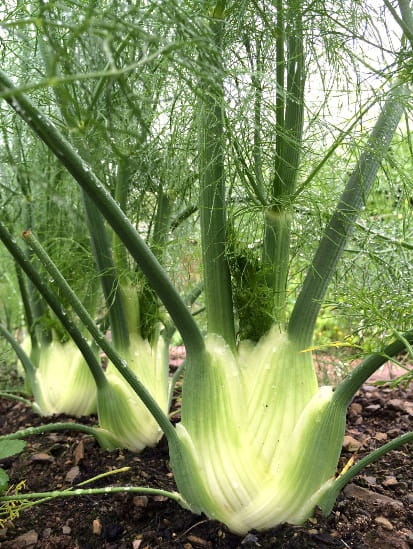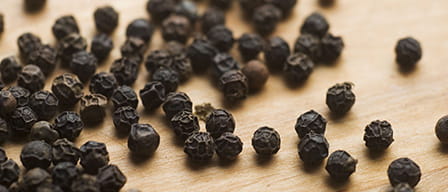
Anise


This herbaceous and aromatic plant, Foeniculum vulgare Mill, belongs to the Apiaceae (umbellifereae) family (celery, carrot or parsley family) and is among the ancient spice plants around the world. The name Foeniculum, used by the Romans, is a form of the Latin foenum, meaning hay, given that fennel smells like hay. Besides the English name fennel, it is also known in Hindi as saunf, Arabic as bisbas and razianaj, Chinese as hui xiang, Dutch as venkel, French as fenouil, Korean as sohoehyang, Japanese as fenneru, and Spanish as hinojo.
Fennel is a hardy and perennial herb, native to southern Europe and the Mediterranean region which can grow 3-9 ft high with a characteristic anise or licorice scent. The bases of its long stems grow together to form a thick, crisp bulb that grows above ground. Above the bulb, at the tip of the stems, are light, feathery leaves that resemble dill. When it goes to seed, fennel also produces small yellow flowers among the leaves.
Sweet and bitter fennel are considered the two major fennel types. Sweet fennel seeds (Foeniculum vulgare var. dulce or piperitum) have a characteristic anise odor and are grown under farm conditions. Their essential oil is rich in trans-anethole, monoterpenes and sesquiterpenes which contribute to the characteristic anise odor of fennel. On the other hand, bitter fennel seeds (Foeniculum vulgare var. vulgare) are grown wild and are rich in the compound estragole. Wild fennel plants have become a significant industrial crop because the estragole constituent is used as an antibacterial agent, and a cosmetic scent. However, health agencies in Europe and Australia have limited use of estragole in different food products because of its possible health risk. There also is another cultivar of fennel plants called Florence fennel (F. vulgare var. azoricum) that is grown for the enlarged bulb at the base of the plant and is mainly used as a cooked vegetable. Sweet fennel is not found in the wild and is seldom invasive, but there are invasive or weedy varieties of Foeniculum vulgare. These cultivars that are considered noxious weeds often form dense infestations that prevent the growth of vegetation critical for native wildlife habitats or other desired plants. Although fennel is grown widely in Europe, North America, North Africa and Asia, India is the prominent producer.


Fennel was an important plant cultivated by the ancient Egyptians, Romans, Indians, and Chinese. In early Sanskrit writings in India, fennel was known as madhurika and its cultivation in India dates back to at least 2000 BC. To the ancient Greeks, fennel represented success and was called marathon because the battle of Marathon (490 BC) was fought in a fennel field. Fennel was also a triumph symbol for the Romans and leaves were used to crown winners of games. Pliny the Elder, the Roman author of Naturalis Historia, believed that serpents ate and rubbed against fennel because it was able to improve their eyesight after shedding their skins. Emperor Charlemagne encouraged the cultivation of fennel in Central Europe which was considered a royal spice, served to kings with fruit, bread, and in fish dishes as early as the 13th century. As such, fennel was a staple in the household of King Edward I of England whose records document purchases of pound quantities of fennel seed, an impressive supply. Spanish missionaries cultivated fennel in North America in their medical gardens. In New England colonies English settlers cultivated this herb in kitchen gardens and for the Puritans fennel was used as an appetite suppressant to get through days of fasting. It was not uncommon that handkerchiefs of churchgoers were filled with fennel seeds to nibble on during long services, which led them to be referred to as “meeting seeds”. Fennel also was considered a magical herb because of its ability to protect the individual from the harm of evil spirits.
Foeniculum vulgare has been extensively used for thousands of years to treat a wide range of ailments. Topically, fennel powder is used as a poultice for snake bites. In Asian cultures fennel was ingested to speed the elimination of poisons. Fennel was used in the Greek, Indian, Arabic and Iranian traditional systems of alternative medicine. Different parts of the plant were employed to treat many digestive ailments, diabetes, bronchitis, chronic cough, kidney stones, eye strain and irritation, and to improve eyesight. Intestinal bacteria and hook worm were expelled by using tea prepared with fennel seeds and leaves. Due to its diuretic effect, fennel was also used to treat kidney and bladder diseases, and to relieve nausea. It has been used as a galactagogue for improving the milk supply of a breast-feeding mother and as a fennel water drink was used to alleviate colic of infants. In Brazil a tea brewed from the leaf is used for insomnia and in South Europe and India constipation is treated with seed preparations. A beverage brewed from the leaves is a remedy for arthritis and fever in South Africa. Preparations from the whole plant are a treatment for cough in Mexico, Spain and South Africa. Even children were given stem tips for the calming, sedative effects needed to relieve stress.
The dry fruits or seeds of fennel are elliptical, slightly curved, and greenish-yellow, the color of hay, from which the term fennel is derived. When the color of the green seeds turns brown on the stem, the seeds are harvested and the seed heads are shaken in paper bags to isolate the seeds before drying in trays. The fennel bulb is harvested when it reaches the size of a tennis ball.

Fennel flowers and leaves have a sweet, mildly anise or licorice flavor. Depending on when they are harvested the seeds can have a pungent, mustard taste or a stronger flavor like aniseed or licorice. Fennel bulbs are anise flavored.
All plant parts, from shoot to seed, are widely used as ingredients, raw or cooked, for traditional cuisines all over the world. Fennel stems, leaves, and seeds have been used in preparing meat and fish dishes, pickles, baked goods, sauces, salads, soups, stews, desserts and alcoholic beverages. The fresh leaves are more often used because they do not retain as much flavor when dried. Fennel seeds are sometimes confused with those of anise, which are similar in taste and appearance, though smaller. For cooking, green seeds are preferred. The ground seeds are a key ingredient of Chinese five-spice powder and the Indian spice mixtures garam masala and panch phoron. When the fennel bulb is eaten raw, it has a crisp texture similar to celery and a fresh licorice flavor. When cooked as a vegetable preparation it caramelizes, taking on a sweeter flavor and tender texture, and can be sautéed, stewed, braised, grilled. Many regional dishes in India, Afghanistan, Iran, and the Middle East use fennel seeds. In Iraq, fennel seeds are used as an ingredient in nigella flavored breads. It is a key spice in Kashmiri cuisine and Gujarati cooking. In Syria and Lebanon, the young leaves are used along with onions and flour to make a special kind of egg omelet called ejjeh. In Israel, fennel salad is made of chopped fennel bulbs flavored with salt, black pepper, lemon juice, parsley, olive oil and sometimes sumac. Fennel is a key ingredient in some Italian salads, or it can be braised and served as a warm side dish. In Italy the seeds also are commonly used whole in sausage, salted meats, and various baked goods, and the stem is used to aromatize pickled olives. In Spain, the stems or seeds are used in preserving dry figs, and in the preparation of pickled eggplants, olives, herbal teas and liqueurs. Depending on the region of Portugal, fennel has many diverse applications. The whole plant can be used for aromatizing brandy, the seeds can flavor cakes, pastries, and chestnuts, and the leaves and stems may be fried with eggs, used in fish stuffing or stewed with different beans, chickpeas and fish. In many parts of India and Pakistan, roasted fennel seeds are consumed as a colorful after meal mouth freshener called mukhwas. Mukhwas can be made of various seeds and nuts but often is a combination of fennel seeds, anise seeds, coconut, and sesame seeds.
Our understanding of how fennel and other spices and herbs potentially benefit health is growing. Using diverse spices and herbs as seasonings has been shown to unlock new flavors and tastes that enhance our enjoyment of numerous foods and vegetables, while reducing our intake of added saturated fats, sugar and sodium. Explore ways to incorporate various spices and herbs to create healthy meals and expand your culinary experiences. Learn about recommendations for building a balanced and healthy diet.

Anise

Basil

Bay Leaf

Black Pepper

Black Seed

Cardamom
